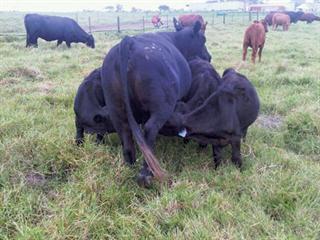With profit margins squeezed to the bone, Mark Stanford faced serious financial problems on his 48ha apple farm Windermere, near Elgin. He knew he had to do something special to survive. “After a trip to Europe, where I visited several apple producers, set out to radically change my approach to apple cultivation,” Mark says. T oday, 14 years later, is achieving the impossible with production techniques that go against the grain of conventional wisdom. “We discourage vegetative growth, instead channelling the trees’ energy into producing apples,” Mark says.
“We achieve this with very close tree spacing and, even in older, conventionally spaced orchards, by using drip irrigation; fertigation; and just enough summer pruning to maintain tree height and shape. Trees are never pruned in winter.” A pple yields of 60t/ha to 70t/ha are considered good, with an industry average of around 40t/ha. On Windermere, Mark consistently harvests 120t/ha Sundown; 100t/ha Pink Lady; 90t/ha Fuji, and 90t/ha Braeburn.
In the older orchards production has increased by between 10t/ha and 15t/ha. Quality is also excellent, with an average of 70% first grade being packed. Currently, the 7ha of apples established in Mark’s revolutionary way are carrying the rest of the farm, he says. “Without them, wouldn’t have been able to survive.” He plans to convert his entire farm towards high density small trees, at a rate of 2ha/year. “Establishing costs are higher, but the returns make it more than worth my while,” he concludes.
Bonsai!
“My initial idea was to drastically reduce the size of my trees, enabling me to have more per hectare and thus increasing yield per hectare,” explains Mark. “figured trees’ root systems should be kept small, and drip irrigation was the answer there. But trees with a small root zone would need extra food to develop a commercial crop, so we added fertigation.
Summer pruning was introduced to inhibit the growth that winter pruning induces. “don’t need trees to grow – need them to bear apples,” Mark says. He plants his trees in 3,5m wide rows with 1m spacing. If the rows were wider, say 4m, the crop would move further away from the tree, using more space without necessarily increasing yield. Narrower rows, say 3m, wouldn’t accommodate a bulk bin, and mean too many tractor rows per hectare in relation to tree rows. Mark says many producers plan their orchards around their equipment, but with the income potential of 1ha of export apples, it should be the other way around.
Making the cut
During pruning, Mark leaves three times more branches than is conventional, resulting in more fruit-bearing wood. In conventional orchards large spacing between branches is needed for light penetration, but because Mark’s trees are small, light penetration is good even though the canopies are denser. Conventional wisdom also dictates that new growth is needed for healthy buds and flowers for the next crop, but on Windermere apple trees have been producing flowers on old wood for 14 years.
The accepted notion that more leaves per apple would ensure healthier fruit, doesn’t apply on Windermere, as some years branches have as many apples as leaves. Trees are topped every third year, maintaining a height of 2,8m, and tree shape is maintained within the rows. Smaller trees allow for harvesting without using ladders. This greatly improves productivity, and a single worker can pick six bins per day, compared with the industry standard of three bins per day. We start irrigating in November until April, irrespective of rainfall.” Trees receive water twice a day. The first irrigation is early in the morning, as trees become active, and this moisture directly affects their performance.
The second application is before 2pm and helps the trees cope with heat stress. “I believe enough moisture during the hot periods greatly reduces sunburn on apples,” explains Mark. “Because my trees have small root zones, moisture uptake is very quick and efficient. Conventional trees with sprawling root zones take a lot longer to get the moisture where it’s needed. Here, although fewer leaves mean less shade, sunburn isn’t a significant problem.”
Drip irrigation only wets a small area, and is topped up to maintain the right moisture levels. “Critics said drip irrigation couldn’t supply the amount of water a commercial tree needs for a good yield, but we proved them wrong,” insists Mark. “We’re also achieving a 70% water saving and my irrigation system is down from three pumps to only one. “Traditional irrigation drenches the soil once or twice a week, but too much water blocks the root system’s access to oxygen, which is vital for nutrient uptake. Drip irrigation forces the roots to go down, instead of spreading horizontally, and this deep penetration minimises moisture loss to evaporation.”
Less fertiliser, better results
Mark never applies nitrogen, as his goal is to discourage excessive growth. Trees receive enough nitrogen from their environment. Potassium, phosphates and microelements are supplied weekly through the dripper lines. “Conventional fertiliser uptake is only 25%, due to factors such as leaching and evaporation,” he explains. “With dripper fertigation, you should get close to 100% efficiency, with the right water application scheduling.
This reduces costs, as fewer chemicals are needed for the desired effect. “I can’t prove it, but I believe microelements are essential for fruit quality.” Mark uses Omnia Citro Spor for trace elements and MPK for potassium and phosphate. MPK has become very expensive recently, so he’ll experiment with other products in future. “I suppose an expensive computerised irrigation system would be nice, but we simply worked out the amounts of fertiliser per irrigation block,” he recalls.
“This is mixed into water in a spray car and inserted into the specific block’s dripper lines. Although simple, we never have problems with sediments or blocked lines. “With normal microjets, I would have needed a team of dedicated people checking the system for blockages and damaged sprinklers. With the drip system, one labourer can easily manage it.” Contact Mark Stanford on (021) 859 9516. |fw









